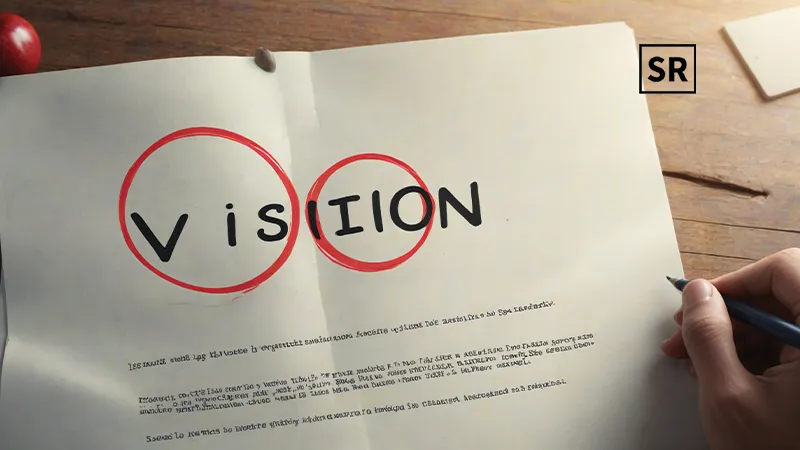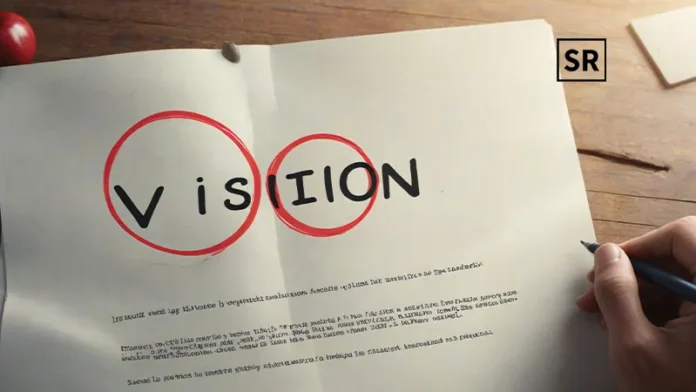
What is a vision statement?
A vision statement clarifies your business’s meaning and purpose for stakeholders, especially employees. It describes the desired long-term results of your company’s efforts. For example, an early Microsoft vision statement was “a computer on every desk and in every home.”
“A company vision statement reveals, at the highest levels, what an organization most hopes to be and achieve in the long term,” said Katie Trauth Taylor, owner and CEO of Untold Content, a writing consultancy. “It serves a somewhat lofty purpose – to harness all the company’s foresight into one impactful statement.”
A vision statement matters because it outlines everyone’s common goal in the company. Businesses working toward a higher aspiration are more appealing to current and future employees.
A vision statement can affect a company’s long-term success, so take the time to craft one that synthesizes your ambition and mobilizes your staff.
What is the difference between a vision statement and a mission statement?
Mission vs. Vision Statements: Understanding Their Roles in Brand Building
A mission statement defines the current purpose of a business, explaining why it exists and where it stands today. In contrast, a vision statement is future-focused, inspiring employees by outlining where the company aims to be.
Paige Arnof-Fenn, founder and CEO of Mavens & Moguls, explains, “The vision is about your future goals and the path to achieving them, while the mission defines your present state and purpose.” She adds, “The vision should motivate the team, giving them a sense of purpose and connection to something bigger than themselves.”
Both mission and vision statements are essential to building a strong brand. While the mission statement highlights the brand’s purpose, the vision statement envisions the future fulfillment of that purpose, according to Jessica Howard, co-CEO of North Star Messaging + Strategy.
Even though both statements are foundational for your organization, the vision statement should act as your company’s beacon, providing long-term direction.
“A vision is about aspirations, while a mission is about actionable steps,” says Jamie Falkowski, chief creative officer at Day One Agency.
Crafting the perfect vision statement may be challenging. Still, by following key guidelines and best practices, you can develop one that truly resonates with your team and guides your business forward.
Quick tips for your vision statement
To create a powerful vision statement, consider the following steps:
- Envision the future: Look ahead for five to ten years.
- Aim high: Focus on success and dream big.
- Please write in the present tense: Make it feel current and achievable.
- Be clear and direct: Avoid jargon and keep the language simple.
- Inspire with passion: Make it motivating and heartfelt.
- Stay aligned: Ensure it reflects your business values and long-term goals.
- Communicate effectively: Develop a strategy to share the vision with your team.
- Dedicate resources: Be ready to invest time and effort into making your vision a reality.
A strong vision statement should provide a clear direction for your company’s future. According to Howard, many clients have successfully used their vision statements to shape their strategic plans. They’ve implemented new marketing strategies, adjusted their focus to better align with their vision, or intensified efforts on key elements of their brand that support their desired outcomes.
What to avoid when writing a vision statement
Don’t mix up your mission statement and vision statement. Mission statements are generally easier to write because they reflect what you’re doing now. Remember, a mission statement is what you are working to accomplish today, while a vision statement is what you want to achieve in the future.
Don’t overthink your wording. The correct wording is one of the most complex parts of creating a vision statement. You may find yourself endlessly rewriting and fretting about getting it right.
Does this sentence or two define your values and shine a light on your corporate identity without sounding too vague? Don’t get lost in the pressure of perfect wording; a specific and unique vision statement is a good place to begin distinguishing your business from the rest of the industry.
5 steps to Write Your Company’s Vision Statement
1. Identify important stakeholders
Your vision statement speaks on behalf of your entire company, so make a list of co-founders, fellow executives, and high-level employees who can help you craft and refine your statement to represent your organization. Getting buy-in from company leaders is also a smart strategic move—the more they believe in the vision statement, the better they’ll model it in their daily work and communicate it to their departments and teams.
Make a second list of stakeholders that represent your vision statement’s audience. This list may consist of personas rather than actual people, and should include:
- Investors
- Board members
- Partner organizations
- Different customer personas
- Employees
- Shareholders
2. Start with a list of keywords
Ultimately, you aim to craft a few concise sentences—crafting those sentences will be much easier if you have a “word bank” to draw from as you write. Hold an open brainstorming session with your internal stakeholders to develop a keyword list.
- Your product or service
- Your mission and values
- Your company’s goals and initiatives
- Your company’s long-term strategic plan
- Adjectives that describe your company, product, teams, community, and ideal future (e.g., expert, innovative, affordable, inspiring)
3. Sort your answers by importance
By the time you’re finished brainstorming, you should have a lot of stuff written down. Put all this content aside for a few days so that your mind is evident when you return for the next step: deciding what goes in your vision statement and what gets left on the cutting room floor.
Sit down with your vision statement tiger team and a highlighter and review everything you have written. Highlight ideas and phrases that your group feels are the most important to your company, and cross out items that you’re ready to eliminate from consideration (however, don’t throw this content out entirely—everything you brainstormed can help create other vital documents, like your core values, roadmap, or business plan).
4. Write a long-form version of your company’s vision
Once you’ve completed step four, you’ll have a condensed list of key phrases, ideas, keywords, and answers to the core questions about your company. The next step is to arrange these ideas into sentences that flow logically, reflecting your company’s priorities.
At this stage, don’t worry about the length. Focus on clearly communicating your vision in a way that addresses all the essential points and resonates with your stakeholders and audience. Refining and shortening a comprehensive statement is more straightforward than expanding one missing crucial details.
5. Write your final vision statement
After refining your vision paragraph and making the necessary adjustments, the next step is to condense it into a clear and concise vision statement. As you gather feedback and incorporate suggestions, your paragraph becomes more streamlined. Consider explicitly asking for input on how to make it more succinct and impactful.
- Eliminate what’s unnecessary. Now that you’ve stepped away from your paragraph a few times and gotten a few rounds of feedback, are there any phrases or ideas that don’t feel as necessary as they did when you wrote it? Cut any parts that feel lackluster or less impactful than the rest of the paragraph.
- Look for synonyms. Are there any areas where you used several words to say something that there’s already a word for? For example, you might replace the phrase “give people the ability to” with “provide access.”
- Edit each concept individually. Chop your paragraph into sentences and chop your sentences into phrases. Pick up each small segment independently and devise a shorter phrase. It helps if you evaluate the smaller segments out of order—hopping around or going backward piece by piece. This will help you notice things that your brain smooths over when reading a complete sentence.
When your vision statement is finished, please bring it back to your stakeholders to get final feedback and make any finishing tweaks.
What to avoid when writing a vision statement
- Don’t mix up your mission statement and vision statement. Mission statements are generally easier to write because they reflect what you’re doing now. Remember, a mission statement is what you are working to accomplish today, while a vision statement is what you want to achieve in the future.
- Don’t overthink your wording. The correct wording is one of the most complex parts of creating a vision statement. You may find yourself endlessly rewriting and fretting about getting it right.
Does this sentence or two define your values and shine a light on your corporate identity without sounding too vague? Don’t get lost in the pressure of perfect wording; a specific and unique vision statement is a good place to begin distinguishing your business from the rest of the industry.
How to use your vision statement
Determine where your vision statement will appear and what its role is in your organization. Shockley said that this will make the process more than an intellectual exercise. It’s pointless to hang a vision statement in the lobby or promote it via your business’s social media channels if you never genuinely integrate it into your company culture.
“The vision business statement should be considered part of your strategic plan,” Shockley said. “It is an internal communications tool that helps align and inspire your team to reach the company’s goals.”
As such, you should view a vision statement as a living document that will be revisited and revised. Most importantly, it must speak directly to your employees.
10 examples of inspiring vision statements
- Amazon: “Our vision is to be earth’s most customer-centric company; to build a place where people can find and discover anything they might want to buy online.”
- Ben & Jerry’s: “Making the best ice cream in the nicest possible way.”
- Caterpillar: “Our vision is a world in which all people’s basic needs – such as shelter, clean water, sanitation, food, and reliable power – are fulfilled in an environmentally sustainable way, and a company that improves the quality of the environment and the communities where we live and work.”
- Cradles to Crayons: “Provides children from birth through age 12, living in homeless or low-income situations, with the essential items they need to thrive – at home, school, and play.”
- Google: “To provide access to the world’s information in one click.”
- Habitat for Humanity: “A world where everyone has a decent place to live.”
- Hilton Hotels & Resorts: “To fill the earth with the light and warmth of hospitality by delivering exceptional experiences – every hotel, every guest, every time.”
- IKEA: “To create a better everyday life for the many people.”
- Intel: “If it’s smart and connected, it’s best with Intel.”
- LinkedIn: “Create economic opportunity for every member of the global workforce.”
Can vision statements change?
Many companies benefit from having a vision statement from their inception, but it’s perfectly acceptable not to commit to one specific vision immediately.
“Getting too tied into one master statement can mess with the learning and creation process in the early stages,” said Sonia Elyss, president of marketing and communications collective Round Twelve. She encourages her clients to write a monthly vision statement, save the previous drafts, and see what sticks and doesn’t over time.
“After the first year, you can look back and see how much you have evolved,” Elyss said. “What parts or words within the statement stuck around, and what was dropped? Those keywords become major brand pillars you can always return to and eventually become part of the brand ethos.”
The Purpose of Your Vision Statement
A vision statement is a powerful tool to help your business grow and achieve long-term success. Throughout your journey, you’ll encounter moments of triumph, challenging periods, unexpected detours, and obstacles of all kinds.
Above all, your vision statement should constantly remind you and your team of the ultimate goal. This clarity and focus are vital during the most challenging days, helping you stay motivated and aligned.





